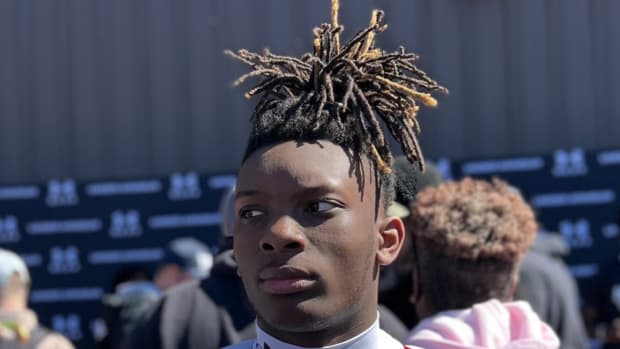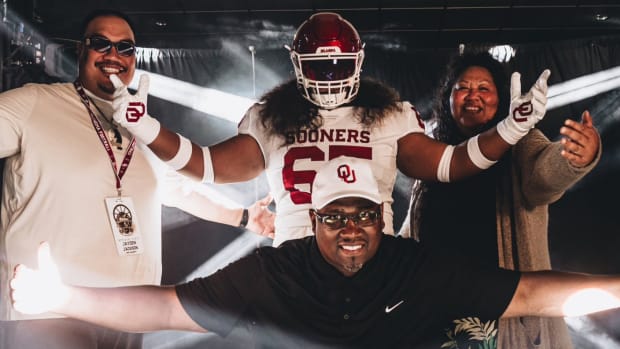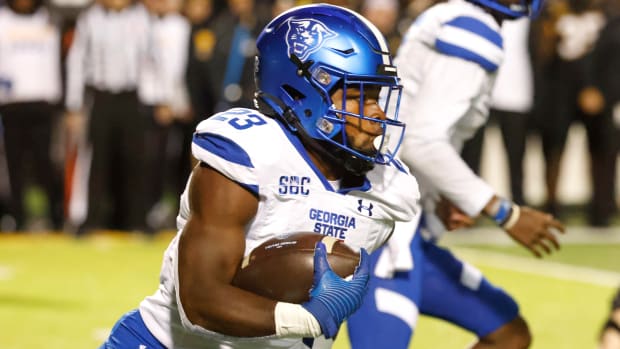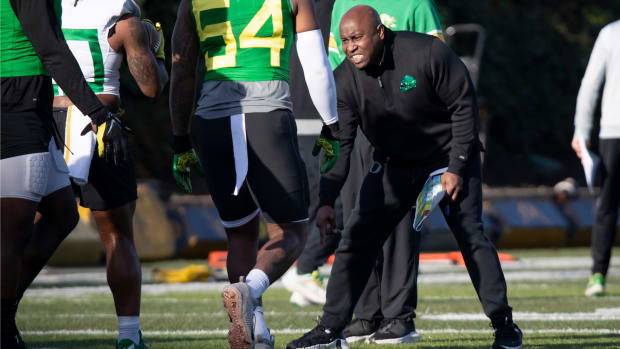FCS Head Coaches Who Land FBS Jobs Face New Problems at College Football's Highest Level
A day before preseason camp began at Alcorn State in 2012, Jay Hopson’s primary concern was, of all things, killing wild hogs. A pack of boars turned his neatly manicured field into a mess ahead of his first practice as coach of the small school in the Mississippi Delta. “It looked like an 18-wheeler did 19 donuts in the middle of my field,” Hopson recalls. The hogs returned the next night, chewed up more turf in their pursuit of grubs and prompted the coach to reach out to the Mississippi Highway Patrol. A week later, Hopson got a late-night phone call from a state trooper informing him that the half-dozen hogs, including one that measured four feet at the shoulder, were shot dead.
You have reached your limit of 4 premium articles
Register your email to get 1 more
With one problem dealt with, Hopson turned his attention to the next varmint impacting his life. “Every day at lunch,” recalls Hopson, now the head coach at Southern Miss, “my GA and I would come out at noon and plug up armadillo holes to make sure our guys wouldn’t tear their ankle up.
“Crazy things like that, those are things at the FBS level you certainly never deal with.”
Hopson’s introduction to life at the most modest corner of Division I, the SWAC, is an extreme illustration of the gap separating college football’s have-nots (Football Championship Subdivision, Division II, Division III and NAIA) from its haves in the Football Bowl Subdivision. It is unlikely that new Kansas State head coach Chris Klieman had a wild hog problem at FCS powerhouse North Dakota State, but Klieman will be the next to get a hands-on look at the other side of the divide.
In a hiring cycle full of surprises—think Mack Brown to North Carolina and Les Miles to Kansas—Klieman on Monday joined former James Madison coach Mike Houston (now at East Carolina) and former Austin Peay head coach Will Healy (Charlotte) as FCS head coaches who have been tabbed to lead FBS programs. In those three’s 48 combined years of coaching, only Klieman has spent time in the FBS, a one-year stay as Kansas’s defensive backs coach in 1997. During the last five years, 13 current FBS head coaches have been hired straight from head jobs at the FCS level or lower.
Klieman’s promotion is unique in that he will make an even bigger jump from FCS head coach to Power 5 head coach, a rare move that might explain the backlash from Kansas State’s clearly uneasy fan base in the aftermath of Bill Snyder’s retirement. Michigan coach Jim Harbaugh was the last to do that, going from San Diego to Stanford in 2007. A decade earlier, Hal Mumme brought his Air Raid offense from Valdosta State to Kentucky. “The football was all the same,” Mumme says, but that’s where many of the similarities stop.
Everything is bigger in the FBS, but that doesn’t always mean everything is better for first-time head coaches. Recruiting is more competitive, changes more rapidly and is stretched into a year-round event. Staffs are so much larger at the FBS level that some FCS-turned-FBS coaches admit they failed to delegate and manage well enough. Budgets are so much greater that organizational structure and prudent spending are imperative. Coaches coming from Division II and Division III must learn a new rulebook in Division I, one that puts more stringent qualifying restrictions on recruits. There is also the scholarship increase to 85–22 more than FCS and 49 more than Division II—that can make things even more complex. “There’s no how-to book. Football is still football,” says David Bailiff, who jumped from FCS Texas State to Rice in 2007. “What I did is when I had questions, I was very fortunate to find a mentor in [then Texas coach] Mack Brown. I could pick up the phone and say, ‘Mack, what do you think?’”
Bailiff’s 11-year tenure at Rice ended after a 1–11 finish in ’17, but he led the Owls to two 10-win seasons, four bowl games and a conference championship. A few coaches have figured out the FBS transition, and their success is potentially influencing this new wave as FBS athletic directors veer away from more traditional promotions. Group of Five head coaches and Power 5 coordinators traditionally make up the pool most FBS ADs pull from when switching head coaches. But 15 active FBS coaches were hired directly from a head job on the FCS, Division II or Division III levels. The two most successful are Harbaugh and Brian Kelly, who won national championships at D-III Grand Valley State before jumping to Central Michigan, to Cincinnati and then to Notre Dame, which he is currently preparing for its first College Football Playoff appearance.
New faces have made a splash recently. Syracuse coach Dino Babers and Tulane coach Willie Fritz are both on their second FBS head coaching gigs after turning their success at the FCS level—Babers at Eastern Illinois and Fritz at Sam Houston State—into wins at Bowling Green and Georgia Southern, respectively. Eastern Michigan coach Chris Creighton, who ran the non-scholarship FCS program at Drake, and UAB’s Bill Clark, who came from Jacksonville State, have turned FBS doormats into regular contenders. Jeff Monken (Georgia Southern to Army), Craig Bohl (North Dakota State to Wyoming) and Lance Leipold (Wisconsin-Whitewater to Buffalo) have recently brought bowl berths to places that had experienced extended postseason droughts.
The list of 15 active coaches doesn’t include guys like Mississippi State’s Joe Moorhead, who used a two-year stay as Penn State’s offensive coordinator to boost his stock as an FBS head coach after a successful run as head coach at Fordham. Wake Forest’s Dave Clawson wedged a one-year stint as Tennessee’s offensive coordinator between gigs at Richmond and Bowling Green. Others like Scott Satterfield (Appalachian State) and Willie Taggart (Western Kentucky) led FCS programs into the world of FBS so successfully that they’re now in the ACC at Louisville and Florida State.
“People look at those really good FCS coaches as being about the same as getting somebody from the Group of Five,” says Mumme, who currently lives in Jackson, Miss., and is coy about his future plans in coaching. “When you add it all up, there’s not that many head coaches in football.” Head coach experience is a prerequisite for many administrators, something proven yet again this latest hiring cycle. Of the 15 FBS jobs filled already, 10 of those went to former head coaches. “In my opinion, it’s hard to hire somebody that doesn’t have head coaching experience,” Fritz says. “I know both of those guys very well, Mike [Houston] and Chris [Klieman]. They’ve proven they can do it at the [FCS] level. It’s tough to turn the keys over to somebody that hasn’t driven before. Those guys have logged a lot of miles.”
Longtime Navy athletic director Chet Gladchuk has hired two football coaches at the school. He plucked one, Paul Johnson, from the FCS level and promoted another, Ken Niumatalolo, from Johnson’s staff upon his departure. “Winners are winners,” Gladchuk says. “I’ve never been one for on-the-job training. I really feel as though if you’re going to entrust a program of significance to someone in a leadership position that person needs a proven track record. I’ve hired assistant coaches through the course of my career in hopes they’d evolve into strong head coaches, and I’ve actually been disappointed.”
For all the success stories of lower-level coaches, there are failures. After being hired from Elon, Pete Lembo won 25 games in his first three seasons at Ball State before the Cardinals regressed and Lembo resigned to join the staff at Maryland, then left after two years to take the same assistant roles at Rice. Everett Withers, who led James Madison to consecutive FCS playoff appearances, won just seven games in three seasons at Texas State, and Mike London, winner of 24 games in two years at FCS Richmond, led Virginia to one bowl game in six years.
Coaches say recruiting is the biggest change that Klieman and Houston will experience. Each cycle is, of course, more intense and competitive—“You’re going after bigger fish,” Hopson says—but it also runs on a different timeline. While FBS signing classes are nearly full by the time a prospect’s high school football season ends in November or December, lower divisions are just getting started. “It’s a little bit of let the chips fall where they may,” says Fritz, who has spent time as a head coach at junior college, Division II and FCS schools. “A lot of the kids are waiting to see what they are going to get.” Offering scholarships to eighth graders and getting commitments from high school sophomores are routine procedures on the FBS level that are nearly non-existent at the lower reaches of the college game. It’s more of a “patient” recruitment, says the 60-year-old Bailiff, now coach at Division II Texas A&M-Commerce. “Everybody thinks they’re going to FBS,” he says. “Whole world does, doesn’t matter how big you are or fast you are. They all have that dream. In FCS, you usually get commitments later.”
While recruiting can be a tricky adjustment, the management of a larger staff and budget are the most difficult obstacles, FCS-turned-FBS coaches agree. The budgets of FBS programs are big enough to quadruple an FCS coach’s staff. At $48 million, James Madison has the largest athletic budget of any FCS program. It would rank No. 62 among FBS schools, according to data from USA Today. With the ability to hire analysts, equipment managers and so on, staffs can swell to more than 50 people, well surpassing those in FCS, especially those in the SWAC.
At Alcorn State, Hopson’s assistants had month-to-month contracts worth as little as $25,000 a year, and his equipment manager was also his strength coach. To stretch a tiny recruiting budget, Hopson convinced a car dealership to loan him eight vehicles at no cost for travel, and he bargained with hotel managers for discounts on room rates for visiting recruits. “You’ve got to come up with innovative ways to make that dollar stretch,” he laughs now. At Kentucky in the late 1990s, Mumme arrived having already in place a holdover from the previous staff, Jack Fligg, who served as his director of football operations. “For these guys moving up you’ve got to have a guy like that to be your eyes and ears in the program,” Mumme says. “Jack was an unsung hero in that whole Air Raid thing at Kentucky. The lesson in that for some of these guys moving up is to find somebody like that who really knows the inner workings of Division I football because it’s incredibly complicated.”
Coaches making the leap directly from FCS to FBS or even from FCS to Power 5 isn’t new. It has happened as far back as 1982, when Jim Whacker left Southwest Texas State for TCU, then a member of the old Southwest Conference with the likes of Texas, Arkansas and Texas A&M. Five years later, Virginia Tech hired a young Murray State coach named Frank Beamer, and 14 more years passed before arguably the most successful FCS-to-FBS head coach made the jump. In 2001, Jim Tressel went from Youngstown State to Ohio State. Around that time, the move up from what was then Division I-AA wasn’t so accessible. “It was nearly impossible,” Mumme says. While at Valdosta State one year, Mumme received interest from a MAC school. The athletic director called to inform the coach he was No. 5 on a five-man list of candidates. Mumme fired back over the telephone: “I’m going to make it easy on you. You can just have four, because I’m not going to be anybody’s fifth choice.”
Klieman, Houston and Healy, meanwhile, head into their FBS jobs with plenty of footprints to follow. A host of coaches continue to pave the way for those at the lower levels to get the call-up, and they all have advice for the FBS rookies: Delegate more, budget smarter, recruit heavier and, Hopson might say, forget about those wild hogs.





